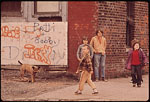This is one of the traditional dramatic games.
One player is chosen to be market man and another buyer; the rest of the players are chickens; they stoop down in a row and clasp their hands under their knees. The buyer approaches the market man and asks, “Have you any chickens for sale?” The market man answers, “Yes, plenty; will you walk around and try them?” Whereupon the buyer goes up to different chickens and tests them by laying over the head his clasped hands, palms downward and pressing inward. The buyer pretends to be dissatisfied with some of the chickens, saying, “This one is too tough,” “This one is too old,” “This one is too fat,” etc., until at last he finds one that suits him, the chickens being supposed to go through this ordeal without smiling.
When a chicken is found that appears to be satisfactory, the buyer and the market man take him by the arms, one on either side, he still remaining in his first position with hands clasped under the knees, and swing him forward and backward three times. Should he stand this test without loosening his own grasp, he is supposed to be all right, and the buyer leads him off to the opposite side of the playground, or home. The game continues until all of the chickens are sold. Any chicken that smiles, or whose arms give way in the swinging test, must pay a forfeit, all of the forfeits being redeemed at the close of the game. Where there are more than ten players, there should be two or more buyers and sellers.
This game is played in various countries: in England as a “Sale of Honey Pots,” in China as a “Fruit Sale,” etc. The version here given is from Italy.
Games for the Playground, Home, School and Gymnasium by Jessie Hubbell Bancroft

